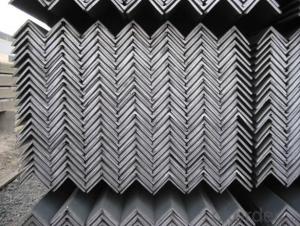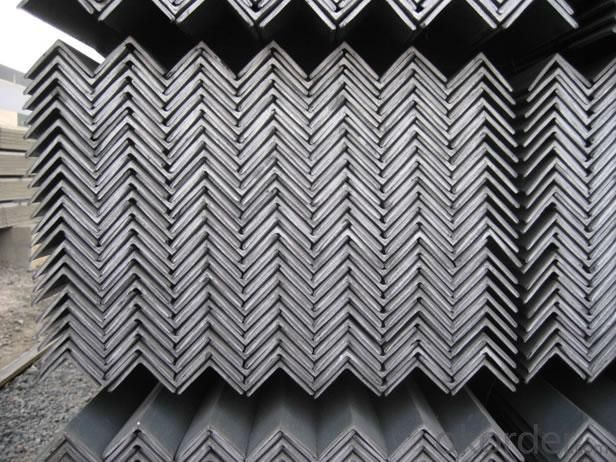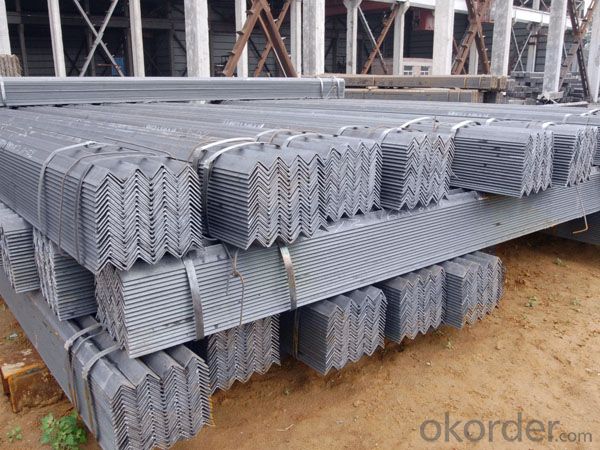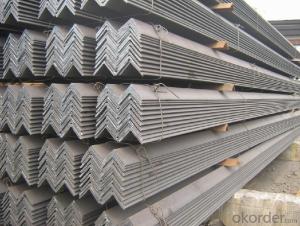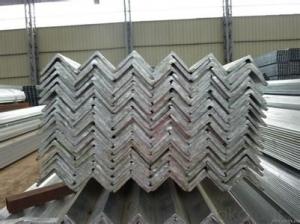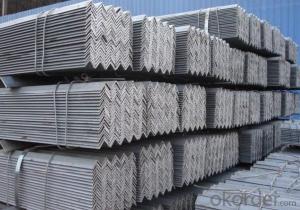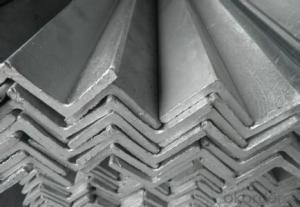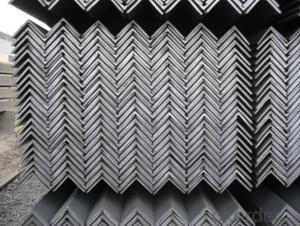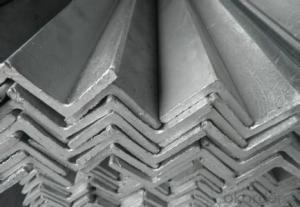high quality angle steel 20-250mm ASTM A36
- Loading Port:
- Shanghai
- Payment Terms:
- TT OR LC
- Min Order Qty:
- 25 m.t.
- Supply Capability:
- 20000 m.t./month
OKorder Service Pledge
OKorder Financial Service
You Might Also Like
Angle steel Details:
| Minimum Order Quantity: | Unit: | m.t | Loading Port: | ||
| Supply Ability: | Payment Terms: | Package: | bundle |
Product Description:
Product Description:
Specifications of Angle Steel
1. Invoicing on theoretical weight or actual weight as customer request
2. Length: 6m, 9m, 12m as following table
3. Sizes

Sizes: 25mm-250mm | ||
a*t | ||
25*2.5-4.0 | 70*6.0-9.0 | 130*9.0-15 |
30*2.5-6.6 | 75*6.0-9.0 | 140*10-14 |
36*3.0-5.0 | 80*5.0-10 | 150*10-20 |
38*2.3-6.0 | 90*7.0-10 | 160*10-16 |
40*3.0-5.0 | 100*6.0-12 | 175*12-15 |
45*4.0-6.0 | 110*8.0-10 | 180*12-18 |
50*4.0-6.0 | 120*6.0-15 | 200*14-25 |
60*4.0-8.0 | 125*8.0-14 | 250*25 |
5. Payment terms:
1).100% irrevocable L/C at sight.
2).30% T/T prepaid and the balance against the copy of B/L.
3).30% T/T prepaid and the balance against L/C
6.Material details:
Alloy No | Grade | Element (%) | |||||
C | Mn | S | P | Si | |||
|
|
|
|
|
|
| |
Q235 | B | 0.12—0.20 | 0.3—0.7 | ≤0.045 | ≤0.045 | ≤0.3 | |
|
|
|
|
|
|
| |
Alloy No | Grade | Yielding strength point( Mpa) | |||||
Thickness (mm) | |||||||
≤16 | >16--40 | >40--60 | >60--100 | ||||
≥ | |||||||
|
|
|
|
|
| ||
Q235 | B | 235 | 225 | 215 | 205 | ||
Alloy No | Grade | Tensile strength (Mpa) | Elongation after fracture (%) | ||||
Thickness (mm) | |||||||
| ≤16 | >16--40 | >40--60 | >60--100 | |||
≥ | |||||||
|
|
|
|
|
|
| |
Q235 | B | 375--500 | 26 | 25 | 24 | 23 | |
Usage & Applications of Angle Steel
According to the needs of different structures, Angle can compose to different force support component, and also can be the connections between components. It is widely used in various building structures and engineering structures such as roof beams, bridges, transmission towers, hoisting machinery and transport machinery, ships, industrial furnaces, reaction tower, container frame and warehouse etc.
Packaging & Delivery of Angle Steel
1. Packing: it is nude packed in bundles by steel wire rod
2. Bundle weight: not more than 3.5MT for bulk vessel; less than 3 MT for container load
3. Marks:
Color marking: There will be color marking on both end of the bundle for the cargo delivered by bulk vessel. That makes it easily to distinguish at the destination port.
Tag mark: there will be tag mark tied up on the bundles. The information usually including supplier logo and name, product name, made in China, shipping marks and other information request by the customer.
If loading by container the marking is not needed, but we will prepare it as customer request.
Production flow of Angle Steel
Material prepare (billet) —heat up—rough rolling—precision rolling—cooling—packing—storage and transportation
- Q: Can steel angles be used for reinforcing steel structures?
- Yes, steel angles can be used for reinforcing steel structures. Steel angles are commonly employed to add strength and stability to various steel structures, such as buildings, bridges, and towers. They provide additional support and help distribute loads more efficiently, making them a suitable choice for reinforcing steel structures.
- Q: Can steel angles be used in seismic-resistant structures?
- Seismic-resistant structures can incorporate steel angles for various purposes. These versatile elements are commonly utilized in buildings and bridges due to their high strength. In seismic-resistant structures, steel angles can be employed in multiple ways to bolster the overall structural integrity and earthquake resistance. When used as bracing elements, steel angles play a crucial role in distributing and dissipating seismic forces. By connecting them diagonally between different structural components, the impact on the structure can be significantly minimized. This prevents excessive deformation or collapse during an earthquake. Moreover, steel angles can reinforce and strengthen key components of the structure. They can be welded or bolted to beams and columns, providing additional support and stiffness. This reinforcement enables the structure to better withstand lateral forces generated by earthquakes, ultimately improving its seismic performance. In the construction of moment-resisting frames, steel angles are essential components. These frames are widely employed in seismic-resistant structures. By utilizing steel angles as the main elements, rigid connections between beams and columns are created. This allows for effective transfer and distribution of seismic forces, reducing structural damage and enhancing earthquake resistance. It is important to adhere to relevant building codes and regulations when incorporating steel angles into seismic-resistant structures. The specific design and detailing requirements may vary depending on the seismic zone and potential earthquake magnitudes. Consulting with structural engineers and following appropriate guidelines is crucial to ensure the safe and effective utilization of steel angles in these structures.
- Q: What are the different types of steel angles available?
- There are several different types of steel angles available, each designed for specific applications and purposes. Some common types include: 1. Equal Angle: Also known as L-shaped angles, these steel angles have equal side lengths and are often used for general structural and construction purposes. They provide excellent support and stability when connected to other structural components. 2. Unequal Angle: As the name suggests, unequal angles have different side lengths. These angles are commonly used in applications where one side needs to be longer or shorter than the other, such as supporting uneven loads or creating specific shapes. 3. Stainless Steel Angle: These angles are made from stainless steel, which is highly resistant to corrosion, making them suitable for applications where exposure to moisture or chemicals is a concern. They are often used in food processing plants, chemical industries, and marine environments. 4. Galvanized Angle: Galvanized steel angles are coated with a layer of zinc, providing excellent corrosion resistance. This makes them ideal for outdoor applications or areas with high humidity or saltwater exposure. 5. Rolled Steel Angle: Rolled steel angles are manufactured by rolling hot-rolled steel into the desired shape. This process enhances the strength and durability of the angle, making it suitable for heavy-duty applications. 6. Slotted Angle: Slotted angles have holes or slots along their length, allowing for easy attachment and adjustment. They are commonly used in shelving systems, workbenches, and storage racks, as they offer a versatile and customizable solution. 7. Structural Steel Angle: These angles are typically used in construction projects requiring load-bearing support. They are designed to withstand heavy loads and provide structural stability in buildings, bridges, and other infrastructure projects. It is important to consider the specific requirements of your project before choosing the appropriate type of steel angle. Consulting with a structural engineer or steel supplier can ensure that you select the right angle for your application.
- Q: What are the different surface treatments available for galvanized steel angles?
- There are several surface treatments available for galvanized steel angles to enhance their appearance, durability, and resistance to corrosion. Some of the commonly used surface treatments for galvanized steel angles include: 1. Powder coating: This involves applying a dry powder to the surface of the galvanized steel angle and then heating it to create a durable and attractive finish. Powder coating can be customized to achieve various colors and textures, providing a high-quality and long-lasting surface treatment. 2. Painting: Galvanized steel angles can also be painted with a variety of coatings, such as epoxy, polyurethane, or enamel paint. Painting provides an added layer of protection against corrosion and can be tailored to match specific aesthetic requirements. 3. Hot-dip galvanizing: This surface treatment is the initial process for galvanized steel angles. It involves immersing the steel angles into a bath of molten zinc, which forms a protective layer on the surface. Hot-dip galvanizing provides excellent corrosion resistance and is ideal for outdoor applications. 4. Zinc electroplating: Similar to hot-dip galvanizing, zinc electroplating involves applying a thin layer of zinc to the surface of the steel angle through an electrochemical process. This treatment provides good corrosion protection and can be combined with other surface treatments for added durability. 5. Anodizing: Anodizing is typically used for aluminum surfaces, but it can also be applied to galvanized steel angles. This process involves creating a controlled oxide layer on the surface, which enhances corrosion resistance and provides a decorative finish. 6. Passivation: Passivation is a chemical treatment that removes iron and other impurities from the surface of galvanized steel angles. This treatment helps improve the corrosion resistance of the steel by creating a passive oxide layer. It is important to select the most appropriate surface treatment for galvanized steel angles based on the specific application requirements, budget constraints, and desired aesthetic appearance. Consulting with a professional or supplier can help determine the most suitable surface treatment for your needs.
- Q: Can steel angles be used for framing applications?
- Indeed, framing applications can utilize steel angles. The durability and strength of steel angles make them frequently employed in construction and framing. They offer structural support and stability for erecting walls, floors, and roofs. Furthermore, steel angles possess versatility, as they can be effortlessly welded, bolted, or screwed together to construct a robust and stable frame. Additionally, they are accessible in assorted sizes and thicknesses to cater to diverse framing necessities. All in all, due to their strength, durability, and user-friendliness, steel angles are widely favored for framing applications.
- Q: How do you calculate the bending moment of a loaded steel angle?
- In order to calculate the bending moment of a loaded steel angle, it is necessary to take into account the applied load, the moment arm, and the cross-sectional properties of the angle. Firstly, one must ascertain the applied load that is acting on the steel angle. This can either be a point load or a distributed load, depending on the specific circumstances. Following this, the point of application of the load must be identified and the moment arm determined. The moment arm represents the perpendicular distance between the point of application of the load and the axis of rotation. Once the applied load and moment arm are known, the bending moment can be calculated using the formula: Bending Moment = Applied Load x Moment Arm Lastly, the cross-sectional properties of the steel angle need to be taken into consideration. These properties encompass the area moment of inertia (I) and the section modulus (Z). The area moment of inertia gauges the resistance to bending and is contingent upon the shape and dimensions of the angle. The section modulus denotes the strength of the section and is computed by dividing the area moment of inertia by the distance from the centroid to the extreme fiber. By employing the appropriate equations and taking into account the cross-sectional properties, it is feasible to ascertain the bending moment capacity of the loaded steel angle and evaluate its structural integrity under the given load conditions.
- Q: What is the maximum allowable torsional stress for a steel angle?
- The maximum allowable torsional stress for a steel angle depends on several factors, including the specific grade of steel, the dimensions and shape of the angle, and the intended application. Steel angles are commonly used in structural applications, such as supporting beams and frames, and they are designed to withstand various types of stresses, including torsional stress. To determine the maximum allowable torsional stress for a steel angle, engineers typically refer to industry standards and codes, such as the American Institute of Steel Construction (AISC) Manual or the European standard EN 10056. These standards provide guidelines and formulas for calculating the maximum allowable torsional stress based on the properties of the steel angle, such as the cross-sectional area, moment of inertia, and modulus of elasticity. It is important to note that the maximum allowable torsional stress is usually specified as a percentage of the yield strength or ultimate tensile strength of the steel. This ensures that the angle can safely withstand torsional loads without undergoing permanent deformation or failure. In practical applications, engineers and designers must carefully analyze the specific requirements and loading conditions to determine the appropriate maximum allowable torsional stress for a steel angle. They consider factors such as the magnitude and direction of the applied torque, the angle's orientation, and any additional loads or constraints that may be present. Ultimately, the maximum allowable torsional stress for a steel angle is a critical parameter in ensuring the structural integrity and safety of a given design. Proper consideration of the steel's properties, industry standards, and specific application requirements is essential for making accurate calculations and selecting an appropriate steel angle that can effectively resist torsional stress.
- Q: What are the different types of steel angles used in bridges?
- There are several types of steel angles used in bridges, including equal angles, unequal angles, and L-shaped angles. These angles are commonly used to provide structural support and reinforcement in bridge construction.
- Q: Can steel angles be used in the construction of railway bridges?
- Yes, steel angles can be used in the construction of railway bridges. They are often used as structural members to provide support and stability to the bridge structure. Steel angles offer strength, durability, and versatility, making them suitable for withstanding heavy loads and harsh environmental conditions typically encountered in railway bridge construction.
- Q: How do steel angles contribute to LEED certification?
- There are several ways in which the use of steel angles can contribute to LEED certification, which is the Leadership in Energy and Environmental Design. Firstly, the production of steel angles often involves the use of recycled steel, reducing the need for new materials and lessening the environmental impact of steel production. Secondly, steel angles have a long lifespan and are highly durable, resulting in reduced maintenance and replacement needs. This, in turn, leads to a decrease in waste generated throughout a building's lifecycle, thus earning LEED credits for minimizing construction and demolition waste. Furthermore, steel angles can be utilized to create efficient structural systems that allow for open and adaptable building designs. This aspect qualifies for LEED recognition in the Innovation in Design category, highlighting exceptional energy and resource efficiency. Additionally, integrating steel angles into a building's design is a straightforward process, making it easier to support sustainable features like solar panels, green roofs, or rainwater harvesting systems. These environmentally friendly features are instrumental in achieving LEED credits for energy efficiency, renewable energy, and water efficiency. In conclusion, the utilization of steel angles in construction contributes to LEED certification through their use of recycled materials, provision of durability and longevity, facilitation of efficient structural systems, and support for sustainable features integration.
Send your message to us
high quality angle steel 20-250mm ASTM A36
- Loading Port:
- Shanghai
- Payment Terms:
- TT OR LC
- Min Order Qty:
- 25 m.t.
- Supply Capability:
- 20000 m.t./month
OKorder Service Pledge
OKorder Financial Service
Similar products
Hot products
Hot Searches
Related keywords
